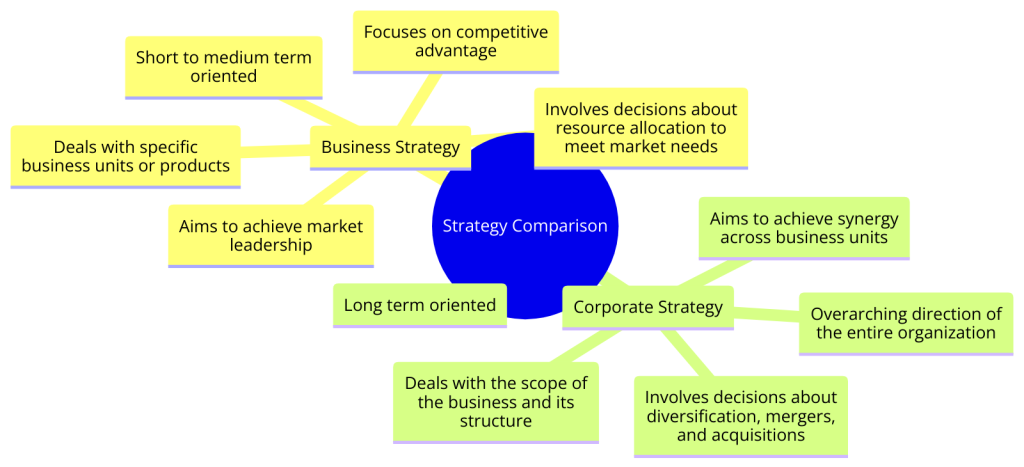What is a business strategy?
A business strategy is a comprehensive plan formulated by an organization to achieve its long-term goals and objectives. It outlines the organization’s direction and guides its decision-making processes on allocating resources, including capital and people, to pursue this strategy. Here are some key aspects of a business strategy:
- Vision and Mission: It starts with the clear articulation of the company’s vision and mission, which define the overarching purpose and goals of the organization.
- Competitive Advantage: The strategy aims to establish or maintain a unique position in the market that allows the business to outperform its competitors. This could be through superior products, lower costs, brand strength, or other differentiators.
- Market Analysis: A thorough market analysis, including customers, competitors, and the overall industry environment, is a critical part of formulating a business strategy. This helps in identifying opportunities and threats in the external environment.
- Internal Analysis: Understanding the company’s internal strengths and weaknesses is equally important. This includes analyzing the company’s resources, capabilities, processes, and financial position.
- Strategic Objectives: Strategic objectives are set based on external and internal analyses. The company aims to achieve These specific, measurable goals within a certain timeframe.
- Tactics and Actions: The strategy also includes the development of specific tactics and actions that will be used to achieve the strategic objectives. This could involve developing new products, entering new markets, improving operations, or other initiatives.
- Resource Allocation: A crucial part of the strategy is deciding how to allocate the organization’s resources effectively across different initiatives to maximize the chances of achieving the strategic objectives.
- Performance Monitoring: Finally, a business strategy includes mechanisms for monitoring performance against the strategic objectives and adjusting the plan based on performance and changes in the external environment.
A well-crafted business strategy should guide the entire organization toward achieving its long-term goals while being flexible enough to adapt to changes in the external environment.
How to make a business strategy
Creating a business strategy involves a comprehensive process to define your company’s vision, objectives, and steps to achieve them. Here’s a structured approach to developing a business strategy:
- Define Your Vision: Start by articulating a clear and compelling vision of what you want your organization to become in the future. This vision will guide the direction of your business strategy.
- Set Clear Objectives: Establish specific, measurable, achievable, relevant, and time-bound (SMART) objectives that align with your vision. These objectives should clarify what you intend to achieve in the short and long term.
- Conduct a SWOT Analysis: Analyze your company’s internal strengths and weaknesses, as well as external opportunities and threats. This will help you understand the internal and external factors impacting your strategy.
- Understand Your Market and Competition: Conduct market research to gain insights into your industry, customers, and competitors. Understanding the market landscape is crucial for identifying opportunities and threats.
- Define Your Value Proposition: Clearly articulate your business’s unique value to customers. This involves understanding what sets your products or services apart from competitors.
- Outline Your Strategic Priorities: Based on your SWOT analysis and market understanding, identify the key areas your business needs to focus on to achieve its objectives. These priorities will guide your actions and resource allocation.
- Develop Action Plans: For each strategic priority, develop detailed action plans that outline the specific steps, resources, and timelines required to achieve your objectives. This should include defining key performance indicators (KPIs) to measure progress.
- Allocate Resources: Determine the resources (financial, human, technological) required to implement your action plans. Ensure that you allocate resources efficiently to maximize impact.
- Implement and Monitor: Execute your action plans and monitor progress against your objectives and KPIs. This involves tracking performance, analyzing outcomes, and making adjustments as needed.
- Review and Adapt: Business environments are dynamic, so reviewing your strategy and adapting it regularly is essential. This might involve revising your objectives, strategic priorities, or action plans.
Remember, a successful business strategy is not just about planning but also about execution and adaptability. It requires continuous evaluation and the willingness to adjust to align with your vision and objectives.
What are the levels of business strategy?
Business strategy can be divided into three levels: corporate, business, and functional.
Corporate level strategy
A corporate-level strategy is a long-term plan that a company uses to guide its business decisions and activities. A corporate-level strategy typically focuses on how the company will compete in its overall industry or market.
This can involve decisions about which businesses to operate in, what products or services to offer, and how to allocate resources across the company. Senior executives usually develop corporate-level strategies and are designed to help businesses achieve their overall goals.
When crafting a corporate strategy, businesses must consider their strengths and weaknesses and the opportunities and threats in their industry. By considering all of these factors, companies can develop a plan that will allow them to compete effectively and achieve their desired success.
Corporate Level Strategy: Explained with Examples and Types
Business level strategy
A business-level strategy is a plan of action to achieve a specific goal. This could be anything from increasing market share to expanding into new markets.
A business-level strategy must be aligned with the company’s overall mission and goals to succeed. It should also consider the company’s strengths and weaknesses and the threats and opportunities present in the marketplace.
Once a business-level strategy has been formulated, it is crucial to implement it in a consistent and disciplined manner. Otherwise, it will simply be another worthless piece of paper gathering dust on a shelf.
Business Level Strategy: Explained with Examples and Types
Functional level strategy
A functional-level strategy is a plan that focuses on how a company will use its resources to achieve its goals in a specific business area.
For example, a company’s marketing functional level strategy might focus on how it will use its marketing budget to reach its target customers. A functional-level strategy is generally created by a company’s top managers and is then implemented by lower-level managers.
While a functional-level strategy is often aligned with the company’s overall business strategy, it can also be adapted to meet the needs of a specific business unit or product line. By taking into account each business unit’s unique resources and objectives, a company can develop a more targeted and practical approach to achieving its goals.
For a company to be successful, all three levels of strategy must be aligned. Otherwise, there will be confusion and conflict between different departments, leading to stagnation or even decline.
By developing a clear and concise business strategy, companies can ensure that all levels of the organization work together towards a common goal.
Functional Level Strategy: Explained with Examples and Types
Examples of business strategy
A business strategy is a plan that outlines how a company will achieve its goals. There are many different business strategies, but some common examples include cost leadership, differentiation, and focus.
Cost leadership
Cost leadership creates a competitive advantage by having the lowest cost of production in their respective industry. This strategy is often used by companies that can produce their goods or services at a lower price than their competitors.
To achieve a cost leadership position, businesses must achieve economies of scale, which refers to producing goods or services at a lower unit cost as production increases.
There are several ways that businesses can achieve economies of scale, such as through vertical integration, investing in new technology, or streamlining their manufacturing process.
Once a business has achieved a cost leadership position, it can maintain it by continuously lowering its costs and/or raising its prices.
What is a Cost leadership strategy | Explained with Examples
Differentiation
A differentiation strategy is where a company seeks to distinguish itself from the competition by offering unique products or services.
This can be done in terms of quality, features, design, or any other aspect that sets the company’s products or services apart from its rivals.
A differentiation strategy aims to make the company’s products or services more attractive to customers and thus gain a competitive advantage in the marketplace.
While a differentiation strategy can be an effective way to grow a business, it can also be challenging to sustain over the long term due to the constant need to innovate and remain ahead of the competition.
Product differentiation Strategy in marketing with types & examples
Focus
A focus strategy involves targeting a specific market niche or segment. Focus Strategy: All you need to know
A focus strategy aims to gain a competitive advantage by catering to the target market’s unique needs. Focus strategies can be either cost-based or differentiation-based.
Focus strategies can effectively build brand loyalty and increase market share, but they can also be tricky to execute. Because focus strategies involve targeting a specific market segment, companies must be careful not to spread themselves too thin or risk losing their competitive advantage.
Each strategy has its benefits and drawbacks, and the best strategy for any given company will depend on its specific goals and situation.
However, all businesses need some strategy to be successful. Without a plan to achieve its goals, a company will likely flounder and ultimately fail.
Innovation focused business strategy of Godrej
How to measure the effectiveness of a business strategy
Measuring the effectiveness of a business strategy involves evaluating how well the strategy has achieved its objectives and contributed to the overall vision and goals of the organization. Here are vital steps and metrics to consider in this process:
- Key Performance Indicators (KPIs): Identify specific, quantifiable indicators directly linked to the strategic objectives. KPIs can vary widely depending on the nature of the strategy and the business, including financial metrics, customer satisfaction scores, market share, operational efficiency, and employee engagement levels.
- Financial Performance: Assess the impact of the strategy on the company’s financial health, including revenue growth, profit margins, return on investment (ROI), and cash flow. These metrics provide a clear picture of the financial viability and success of the strategy.
- Market Position and Share: Evaluate changes in your market position and share as a result of the strategy. Gains in market share or improvements in positioning against competitors can indicate the effectiveness of market-oriented strategic initiatives.
- Customer Metrics: Measure customer-related metrics such as customer satisfaction scores, customer retention rates, net promoter scores (NPS), and customer acquisition costs. These metrics can help assess how well the strategy resonates with customers and contributes to loyalty and growth.
- Operational Efficiency: Look at improvements in operational metrics such as production costs, turnaround times, error rates, and quality indicators. Enhancements in these areas can signal the successful implementation of operational or process-oriented strategies.
- Employee Engagement and Productivity: Evaluate employee-related metrics, including employee satisfaction, turnover rates, and productivity levels. A successful strategy should also positively impact the workforce, driving engagement and efficiency.
- Strategic Milestones: Track progress against strategic milestones and timelines. Assessing the completion of critical initiatives and projects on schedule can provide insights into the execution effectiveness of the strategy.
- Benchmarking: Compare your performance against industry benchmarks or competitors to gauge your strategy’s relative effectiveness. This can provide a broader perspective on how well your plan is performing in the competitive landscape.
- Feedback Loops: Implement feedback mechanisms from customers, employees, and other stakeholders to gather qualitative insights into the strategy’s impact. Feedback can provide valuable context to the quantitative data and highlight areas for improvement.
- Adaptability and Resilience: Assess how well the strategy has enabled the organization to adapt to unforeseen challenges or market changes. A strategy’s ability to provide flexibility and resilience can be a critical measure of its long-term effectiveness.
It’s essential to review these metrics and adjust your strategy as needed regularly. Effective measurement is an ongoing process, and insights gained from this evaluation should inform future strategic decisions and adjustments.
IDEO’s Design Thinking Strategy – Making consumers fall in love with your products
How to implement a successful business strategy
Any business owner knows that a successful company requires a well-thought-out strategy. But what goes into a successful business strategy?
Implementing a successful business strategy requires a thoughtful and systematic approach. Here are some steps you might consider:
- Set Clear Goals: Defining what success looks like is crucial before you start. Your business goals should be specific, measurable, attainable, relevant, and time-bound (SMART). Your strategy should be designed to help you achieve these goals.
- Conduct a SWOT Analysis: A SWOT analysis helps you understand your business’s strengths, weaknesses, opportunities, and threats. It provides a clear understanding of your current position, which is essential for strategy development.
- Understand Your Customers: Knowing your customer’s needs and preferences is vital. This understanding will allow you to make strategic decisions that will satisfy your customers and make your business more competitive.
- Understand Your Competitors: Knowing who your competitors are and what they offer can help you differentiate your products or services and find a competitive advantage.
- Formulate the Strategy: Based on the knowledge gained from the previous steps, develop a strategy that leverages your strengths, minimizes your weaknesses, capitalizes on opportunities, and mitigates threats. This strategy should address all key areas of your business, such as product development, marketing, sales, operations, and customer service.
- Communicate the Strategy: Once you have a strategy in place, communicate it clearly and consistently to all stakeholders, including employees, shareholders, and customers. Everyone should understand the direction the business is headed and their role in getting there.
- Implement the Strategy: This is where the rubber meets the road. Start executing the strategy. Ensure all actions and decisions align with the strategic goals. You might need to change your operations, develop new products, enter new markets, etc.
- Monitor and Adjust: Implementation is not a one-and-done process. Regularly review the strategy’s progress and effectiveness using key performance indicators (KPIs). If something isn’t working as expected, don’t be afraid to adjust your strategy.
- Innovation: A successful strategy often includes a focus on innovation. This could mean developing new products or services, or it could involve finding more efficient ways of doing things.
- Culture and Leadership: A positive culture and strong leadership are crucial for a successful strategy. Leaders should embody the strategy and inspire others to work towards it. Likewise, a culture that encourages collaboration, risk-taking, and continuous learning can accelerate strategy implementation.
Remember, every business is unique, and what works for one might not work for another. It’s important to be flexible and adaptable and continuously learn and refine your strategy based on what’s working and what’s not.
Difference between business strategy and corporate strategy
Business strategy and corporate strategy are two different levels of strategic planning in an organization. They both are essential for organizational success, but they focus on different aspects of the organization.
Corporate Strategy:
This is concerned with the overall scope and direction of the entire organization. It involves making decisions about the organization’s portfolio of businesses (if it is a conglomerate with multiple lines of businesses), the markets it will operate in, and how it will create value across those different businesses.
The focus of the corporate strategy is on capital allocation, mergers and acquisitions, and defining the overall corporate identity. The main goal of corporate strategy is to ensure the organization is diversified and balanced in a way that reduces risks and enhances corporate value. In other words, it looks at “what” businesses the company should be in.
Corporate Level Strategy: Explained with Examples and Types
Business Strategy:
This operates at a lower level and is concerned with how a single business unit competes within its specific market. It outlines how to achieve a competitive advantage in the marketplace. Business strategy involves decisions about product development, customer targeting, marketing, production, distribution, and pricing.
It’s more focused on operational effectiveness and strategic positioning within the market. This strategy primarily responds to the question of “how” the business will succeed in a specific market.
In summary, corporate strategy is more big-picture, determining where and how the organization will compete, whereas business strategy focuses on executing the corporate strategy within specific markets.

The real challenge in crafting strategy lies in detecting subtle discontinuities that may undermine a business in the future. And for that there is no technique, no program, just a sharp mind in touch with the situation
Henry Mintzberg, management thinker and “enfant terrible” of strategic planning theory











